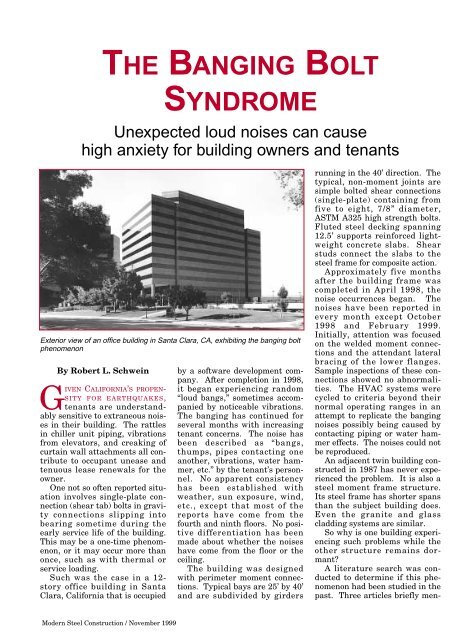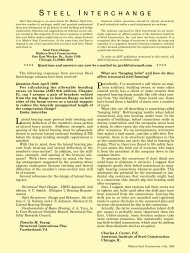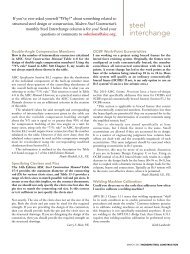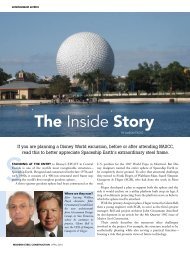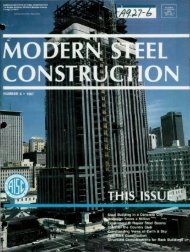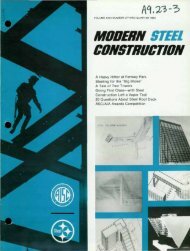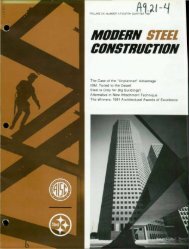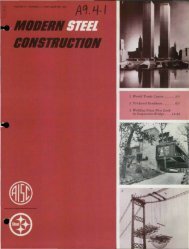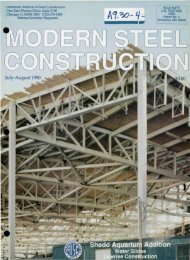THE BANGING BOLT SYNDROME - Modern Steel Construction
THE BANGING BOLT SYNDROME - Modern Steel Construction
THE BANGING BOLT SYNDROME - Modern Steel Construction
Create successful ePaper yourself
Turn your PDF publications into a flip-book with our unique Google optimized e-Paper software.
<strong>THE</strong> <strong>BANGING</strong> <strong>BOLT</strong><br />
<strong>SYNDROME</strong><br />
Unexpected loud noises can cause<br />
high anxiety for building owners and tenants<br />
Exterior view of an office building in Santa Clara, CA, exhibiting the banging bolt<br />
phenomenon<br />
By Robert L. Schwein<br />
GIVEN CALIFORNIA’S PROPEN-<br />
SITY FOR EARTHQUAKES,<br />
tenants are understandably<br />
sensitive to extraneous noises<br />
in their building. The rattles<br />
in chiller unit piping, vibrations<br />
from elevators, and creaking of<br />
curtain wall attachments all contribute<br />
to occupant unease and<br />
tenuous lease renewals for the<br />
owner.<br />
One not so often reported situation<br />
involves single-plate connection<br />
(shear tab) bolts in gravity<br />
connections slipping into<br />
bearing sometime during the<br />
early service life of the building.<br />
This may be a one-time phenomenon,<br />
or it may occur more than<br />
once, such as with thermal or<br />
service loading.<br />
Such was the case in a 12story<br />
office building in Santa<br />
Clara, California that is occupied<br />
<strong>Modern</strong> <strong>Steel</strong> <strong>Construction</strong> / November 1999<br />
by a software development company.<br />
After completion in 1998,<br />
it began experiencing random<br />
“loud bangs,” sometimes accompanied<br />
by noticeable vibrations.<br />
The banging has continued for<br />
several months with increasing<br />
tenant concerns. The noise has<br />
been described as “bangs,<br />
thumps, pipes contacting one<br />
another, vibrations, water hammer,<br />
etc.” by the tenant’s personnel.<br />
No apparent consistency<br />
has been established with<br />
weather, sun exposure, wind,<br />
etc., except that most of the<br />
reports have come from the<br />
fourth and ninth floors. No positive<br />
differentiation has been<br />
made about whether the noises<br />
have come from the floor or the<br />
ceiling.<br />
The building was designed<br />
with perimeter moment connections.<br />
Typical bays are 25’ by 40’<br />
and are subdivided by girders<br />
running in the 40’ direction. The<br />
typical, non-moment joints are<br />
simple bolted shear connections<br />
(single-plate) containing from<br />
five to eight, 7/8” diameter,<br />
ASTM A325 high strength bolts.<br />
Fluted steel decking spanning<br />
12.5’ supports reinforced lightweight<br />
concrete slabs. Shear<br />
studs connect the slabs to the<br />
steel frame for composite action.<br />
Approximately five months<br />
after the building frame was<br />
completed in April 1998, the<br />
noise occurrences began. The<br />
noises have been reported in<br />
every month except October<br />
1998 and February 1999.<br />
Initially, attention was focused<br />
on the welded moment connections<br />
and the attendant lateral<br />
bracing of the lower flanges.<br />
Sample inspections of these connections<br />
showed no abnormalities.<br />
The HVAC systems were<br />
cycled to criteria beyond their<br />
normal operating ranges in an<br />
attempt to replicate the banging<br />
noises possibly being caused by<br />
contacting piping or water hammer<br />
effects. The noises could not<br />
be reproduced.<br />
An adjacent twin building constructed<br />
in 1987 has never experienced<br />
the problem. It is also a<br />
steel moment frame structure.<br />
Its steel frame has shorter spans<br />
than the subject building does.<br />
Even the granite and glass<br />
cladding systems are similar.<br />
So why is one building experiencing<br />
such problems while the<br />
other structure remains dormant?<br />
A literature search was conducted<br />
to determine if this phenomenon<br />
had been studied in the<br />
past. Three articles briefly men-
tion related issues:<br />
“High Strength Bolting:<br />
Recent Research and Design<br />
Practice,” by Birkemoe, P.E.,<br />
Proceedings of W. H. Munse<br />
Symposium on Behavior of<br />
<strong>Steel</strong> Structures - Research to<br />
Practice, by W. J. Hall and M.<br />
P. Gaus, Editors, ASCE, New<br />
York, NY.<br />
“Lack of Fit in High Strength<br />
Connections,” by Mann, A. P.,<br />
& Morris, L. J. (1984),<br />
Journal of Structural<br />
Engineering, ASCE, Vol. 110,<br />
(No. 6; June), pp 1235-1252.<br />
“Compendium of Design Office<br />
Problems,” Committee on<br />
Design of <strong>Steel</strong> Building<br />
Structures of the Committee<br />
on Metals, Structural<br />
Division, Journal of<br />
Structural Engineering, Vol<br />
118, No. 12, December, 1992.<br />
These papers reported on building<br />
noises and their probable<br />
cause of bolts slipping into bearing<br />
with the attendant noise;<br />
however, they did not study the<br />
actual mechanism which may<br />
have induced stresses into the<br />
steel members to cause the joint<br />
slippage. Colleagues from various<br />
parts of the United States<br />
Figure 1: Fifth floor framing (red dots indicate de-torquing noise events)<br />
N<br />
were contacted for their experience<br />
with this phenomenon.<br />
Two other structural engineers<br />
who I spoke with, Michael<br />
Koob of Wiss, Janney & Elstner<br />
Associates, Northbrook, IL and<br />
Ralph Richards, University of<br />
Arizona, had this same occurrence<br />
in their investigations,<br />
typically with long runs of nonmoment,<br />
gravity loaded, bolted<br />
connections.<br />
The concrete mix designs and<br />
concrete test reports for the deck<br />
placements were evaluated. The<br />
concrete mix design contains a<br />
lightweight aggregate from<br />
Baypor in Port Costa, California<br />
and Olympia sand from Felton,<br />
California. These aggregates<br />
have good drying shrinkage<br />
properties as long as the<br />
water/cement ratio is held low.<br />
No drying shrinkage tests were<br />
run either prior to, or during the<br />
project. This is not uncommon<br />
on routine projects such as this if<br />
the aggregate sources have a history<br />
of satisfactory shrinkage.<br />
The average slump value for all<br />
floor slabs was 5.4”, slightly in<br />
excess of the 4 1 /2” maximum<br />
slump limit. This would result<br />
in higher-than-expected 28-day<br />
drying shrinkage values (probably<br />
in the 0.045 to 0.055%<br />
range). The average compressive<br />
strength for all floor slabs<br />
was 3555 lbs. per square inch,<br />
which complied with the requirement<br />
of 3000 lbs. per square inch<br />
at 28 days. No correlation was<br />
made with these values and the<br />
fourth and ninth floor noise<br />
events.<br />
The structural plan drawings<br />
and details were studied in an<br />
attempt to relate the reported<br />
events with particular locations<br />
in the steel framing. The reported<br />
noise locations were also plotted<br />
on plan drawings of each<br />
floor. There was some concentration<br />
of reported events in the<br />
south-central area of the building<br />
on the fourth and ninth<br />
floors; however, no specific conclusions<br />
could be drawn.<br />
After the above research, it<br />
was decided to alter the focus of<br />
attention from the welded<br />
moment connections to the bolted<br />
gravity connections. We<br />
noted that Lines B and C in the<br />
east-west direction and Lines<br />
2.5, 5 and 6 in the north-south<br />
direction were continuous runs<br />
of approximately 180’ and 108’,<br />
<strong>Modern</strong> <strong>Steel</strong> <strong>Construction</strong> / November 1999
espectively. Postulating that<br />
drying shrinkage of the concrete<br />
deck might be transferring compressive<br />
loads into the steel<br />
framing, these long runs seemed<br />
to be candidates for study. It<br />
was decided to loosen selected<br />
and accessible bolted connections<br />
in an attempt to recreate the<br />
reported noises. Six interior connections<br />
on each of the fifth and<br />
ninth floors at Lines B and C,<br />
2.5, 5 and 6 were selected.<br />
Access was gained to the connections<br />
and the fireproofing<br />
removed from the subject bolts.<br />
The accessible bolts on the four<br />
sides of these connections were<br />
manually loosened with a calibrated<br />
torque wrench, beginning<br />
with the central bolts and working<br />
towards the top and bottom<br />
sequentially. The loosening<br />
torques were measured and<br />
recorded where possible. Some<br />
of the connections were inaccessible<br />
due to HVAC equipment<br />
and firewalls.<br />
After observing and hearing a<br />
few of the noises, they were<br />
classed into two groups: “pings,”<br />
a metallic high-pitched noise and<br />
“bangs”, a heavy low-pitched<br />
noise accompanied by distinct<br />
vibration. Of the 105 bolts tested,<br />
13 pings and eight bangs<br />
were recorded. Twenty-one percent<br />
of the bolts tested respond-<br />
<strong>Modern</strong> <strong>Steel</strong> <strong>Construction</strong> / November 1999<br />
N<br />
ed with either a ping or a bang of<br />
varying magnitude. The majority<br />
of the noises were detected on<br />
the long bay (40’ dimension)<br />
north-south members in the<br />
building. Figures 1 and 2 show<br />
the events graphically. The<br />
torque values averaged approximately<br />
350 lb.-ft. to 400 lb.-ft.<br />
One typical bolt was removed<br />
from a joint. It was a 7 /8” diameter<br />
by 2 1 /4” long ASTM A325,<br />
high strength type. It was a button-head<br />
twist-off type bolt. It<br />
carried an upset “n” symbol on<br />
the head along with the A325<br />
marking. The “n” is believed to<br />
be the mark of the Nucor<br />
Fastener Company. Hardened<br />
washers were present beneath<br />
the nuts. All of the bolts were<br />
re-installed to a 200 lb.-ft. torque<br />
level using a calibrated wrench,<br />
which represents a nominal<br />
snug-tight condition.<br />
Based on the analysis and test<br />
results, it is highly probable that<br />
the reported random noises<br />
which have been occurring in the<br />
building are the result of high<br />
strength bolts slipping into bearing<br />
due to axial compression<br />
loading of the steel frame beam<br />
members. Drying shrinkage of<br />
the lightweight concrete deck<br />
slabs is likely inducing this loading.<br />
Portland cement concrete is<br />
Figure 2: Ninth<br />
floor framing<br />
(red dots indicatedetorquing<br />
noise<br />
events)<br />
mixed with water in excess of<br />
that required for hydration.<br />
This facilitates mobility and<br />
workability of the plastic mix<br />
such that it can be readily<br />
mixed, transported and placed in<br />
the forms. Some of this water is<br />
used up in the chemical process<br />
of hydration of the cement and<br />
the excess leaves the concrete<br />
through evaporation. As the<br />
pore spaces in the paste lose<br />
their water, surface tension<br />
tends to shrink the surrounding<br />
paste, causing shrinkage of the<br />
hardened concrete. This shrinkage<br />
diminishes in time in an<br />
asymptotic manner. Generally,<br />
between 65 and 85% of the ultimate<br />
drying shrinkage occurs in<br />
the first year.<br />
The steel framework is<br />
anchored to the concrete through<br />
the fluted metal decking and the<br />
shear studs, which are installed<br />
for composite action. As the concrete<br />
shrinks, the steel tries to<br />
restrain it, causing compression<br />
in the members and joints.<br />
When these forces exceed the<br />
friction supplied by the bolts in<br />
the gravity members, the bolts<br />
suddenly slip into bearing with<br />
the attendant noises. The smaller<br />
pings are likely individual<br />
bolts slipping, and the large<br />
bangs with accompanying vibrations<br />
are a group of bolts which
all slip into bearing at one time.<br />
The non-moment resisting<br />
shear connections are the most<br />
likely to experience this phenomenon.<br />
The moment resisting connections<br />
with welded flanges and<br />
bolted webs would be less prone<br />
to this bolt slip because the<br />
flange welds, being stiffer, would<br />
attract and resist most of the<br />
strain before the load would<br />
cause bolt slips in the web.<br />
Based on the plots of noises from<br />
the tests shown in Figures 1 and<br />
2, it is apparent that most of the<br />
slips occurred on the longer span<br />
members (40’) running in the<br />
north-south direction. This<br />
Non-slip critical bolted<br />
connections should be made<br />
with high-strength bolts<br />
tightened only to a snug-tight<br />
condition<br />
would be expected due to the<br />
longer members attracting<br />
greater compressive loads with<br />
less chance for relief at the fewer<br />
number of joints. This seems to<br />
correlate with the tenant reports<br />
as well.<br />
The third through ninth floor<br />
steel framing is virtually identical<br />
in plan; however, the members<br />
vary in section size as the<br />
building ascends. The concentration<br />
of the events at the<br />
fourth and ninth floors with a<br />
lack of reported events on the<br />
intermediate floors suggests that<br />
the concrete may have been<br />
placed at a higher water/cement<br />
ratio, hence increasing the<br />
amount of drying shrinkage and<br />
attendant stress in the steel<br />
members.<br />
The only apparent means to<br />
eliminate the noises would be to<br />
loosen all of the bolts on all of<br />
the gravity connections in the<br />
building and return them to a<br />
snug-tight condition. This would<br />
be a huge undertaking, requiring<br />
the removal of many fire walls,<br />
HVAC systems, plumbing lines,<br />
electrical and computer wiring,<br />
etc. as well as being highly disruptive<br />
to the tenant operations.<br />
The Research Council on<br />
Structural Connections (RCSC),<br />
Specification for Structural<br />
Joints Using ASTM A325 or<br />
A490 Bolts, recommends that<br />
non-slip critical bolted connections<br />
be made with high strength<br />
bolts tightened only to a snugtight<br />
condition. A similar recommendation<br />
is found in the AISC<br />
specification. The bolts used in<br />
this structure are an A325 bolt of<br />
a self-regulating torque type<br />
design in which<br />
the assembly is<br />
tightened<br />
through the nut<br />
and reacted<br />
through a<br />
splined tip on<br />
the threaded end<br />
of the bolt. The<br />
assembly then<br />
twists off at a<br />
torque value<br />
that corresponds<br />
to the proper<br />
tension. The calibrated wrench<br />
torque that was measured (375<br />
lb.-ft. average) when the bolts<br />
were loosened appears to be<br />
about 60% of the torque required<br />
to fully tighten the bolts (approximately<br />
715 lb.-ft.). It is probable<br />
that this level of pretension<br />
is more than required for the<br />
minimum condition of snug-tight<br />
and may have contributed to the<br />
banging bolt phenomenon.<br />
In the case at hand, the<br />
installed pretension combined<br />
with the slip resistance on the<br />
faying surfaces (which were not<br />
specifically prepared to achieve<br />
any specific class of slip resistance)<br />
results in some nominal<br />
frictional resistance that initially<br />
carries load. In many cases, this<br />
frictional resistance is overcome<br />
during construction. However,<br />
in some of the referenced cases,<br />
the frictional resistance was not<br />
overcome until the building was<br />
in service. In several instances,<br />
the attendant slip was accompanied<br />
by noise.<br />
The simplicity of using only<br />
one type of bolt on a job for both<br />
slip-critical and bearing connections<br />
probably imparts some<br />
economies as well as eliminating<br />
confusion by the ironworkers.<br />
Common practice in erection is<br />
to use the same impact wrenches<br />
on all bolts. If necessary, noises<br />
such as those described can be<br />
minimized by installing the tension-control<br />
bolts to the snugtight<br />
condition, but without actually<br />
severing the splined end.<br />
On average, this will reduce the<br />
actual pretension in the joint<br />
and increase the likelihood that<br />
the connections will slip into<br />
bearing well before occupancy.<br />
In the end, however, the conditions<br />
creating the noises are<br />
not of structural significance and<br />
in no way affect the integrity of<br />
the building’s structural system<br />
nor compromise its ability to<br />
resist the seismic, wind or gravity<br />
loading that it was designed<br />
to accommodate. Given this, it<br />
was recommended that no corrective<br />
action be taken. The<br />
noise events will probably continue<br />
at a lesser and lesser rate<br />
for another year or so and then<br />
cease as the concrete shrinkage<br />
diminishes with time and more<br />
bolts slip into bearing.<br />
Robert L. Schwein is a principal<br />
of Schwein/Christensen<br />
Laboratories, Inc., a materials<br />
engineering and research laboratory<br />
in Lafayette, CA<br />
(www.sclabs.net). He can be contacted<br />
at: rschwein@sclabs.net<br />
<strong>Modern</strong> <strong>Steel</strong> <strong>Construction</strong> / November 1999


